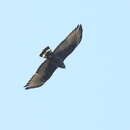en
names in breadcrumbs


Perception Channels: visual ; tactile ; acoustic ; chemical
Not federally or state Threatened or Endangered except Threatened in Texas (Johnson et al 2000).
US Migratory Bird Act: protected
US Federal List: no special status
CITES: no special status
IUCN Red List of Threatened Species: least concern
Believed by some to be a pest, viewed as a "chicken hawk". (Johnson et al 2000)
The diet of the Zone-tailed Hawk includes many small vertebrates (birds, especially passerines; mammals, especially ground squirrels and chipmunks; amphibians and reptiles, particularly the common collared lizard and crevice spiny lizard; rarely fish) (Sherrod 1978). Prey that is exposed and becomes conditioned to the harmless presence of Turkey Vultures is likely prey of the Zone-tailed Hawk (Willis 1963, Zimmerman 1976, Synder and Synder 1991). The hawk is believed to mimic the Turkey Vulture in flight to take advantage of prey that is desensitized to the presence of vultures. Alternatively, dihedral wing shape may simply help stabilize low flight over rough terrain (Mueller 1972, 1976).
The Zone-tailed Hawk circles 40-105m above ground with wings in dihedral position before stooping on prey (McLaran and MacInnis 1977). Also circles at altitude of 15-60m; after sighting prey, continues to circle, dropping behind cover, turning swiftly and, when possible, approaching behind cover to within 0.5-2m of prey before striking (Snyder in Palmer 1988).
Primary Diet: carnivore (Eats terrestrial vertebrates)
The Zone-tailed Hawk is found from the southwestern United States to Central and South America (Johnson et al. 2000).
Biogeographic Regions: nearctic (Native ); neotropical (Native )
Riparian forest and woodland, desert uplands, and mixed conifer forests (Johnson et al. 2000).
Range elevation: 0 to 2200 m.
Habitat Regions: temperate ; tropical
Terrestrial Biomes: desert or dune ; forest
Other Habitat Features: riparian
The Zone-tailed Hawk is a dark hawk (black with brown cast) lacking the light morphology commonly found in many Buteo species. The tail has 2 to 3 light bands that are white when viewed from below. The under-wing is two-toned with black wing tips. The legs and beak of the Zone-tailed Hawk are yellow. The female is slightly larger than the males of this species. The immature hawk is a little darker with white spots around head and on under parts. The immature hawk has many narrow blackish bands on tail. (Johnson et al. 2000)
Range mass: 610 to 940 g.
Range length: 45 to 56 cm.
Range wingspan: 119 to 140 cm.
Other Physical Features: endothermic ; bilateral symmetry
Believed to be monogamous.
Mating System: monogamous
The Zone-tailed Hawk engages in spectacular courtship displays. During these displays aerial loops, dives, and rolls are performed. Heights of up to 500 m are achieved during these ritualized interactions between male and females. Female Zone-tailed Hawks lay one or two eggs per clutch. While in the southwestern United States these hawks breed only once, not much is known about their breeding habits in South America except that year-round residents breed only once.(Johnson et al. 2000)
Breeding season: March to May
Range eggs per season: 1 to 3.
Range time to hatching: 28 to 34 days.
Range fledging age: 28 to 35 days.
Key Reproductive Features: iteroparous ; seasonal breeding ; gonochoric/gonochoristic/dioecious (sexes separate); sexual ; fertilization (Internal ); oviparous
Young are semi-altricial at hatching, with grey down. Female parent incubates, while male parent collects food for the female and young. (Baicich and Harrison 1997; Johnson et al. 2000)
Growth is gradual to slow during first 7 days; between days 7-21, growth is rapid. Cases of siblicide have been documented. (Johnson et al. 2000)
Parental Investment: altricial ; male parental care ; female parental care